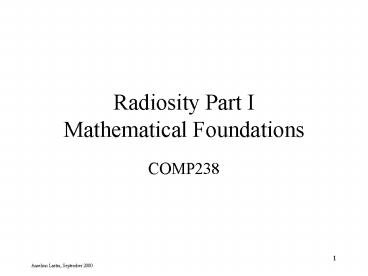Radiosity Part I Mathematical Foundations - PowerPoint PPT Presentation
1 / 44
Title:
Radiosity Part I Mathematical Foundations
Description:
To obtain a mathematical basis for radiosity. Next, the practical details. ... Grouping (note Bj independent of x') Anselmo Lastra, September 2000. 23. Matrix Form ... – PowerPoint PPT presentation
Number of Views:28
Avg rating:3.0/5.0
Title: Radiosity Part I Mathematical Foundations
1
Radiosity Part IMathematical Foundations
- COMP238
2
Goal
- To obtain a mathematical basis for radiosity.
- Next, the practical details.
3
Rendering Equation
- Recall
- We want to simplify enough to solve
4
Radiosity Assumptions
- 1. Opaque surfaces
- 2. Vacuum
- 3. Purely diffuse surfaces
- Solve in object space
- Solution represented in object space
- View independent render as tris w/ vertex color
5
Other Surfaces
- Lets relate incoming radiance to other surfaces
- where
- and is 0 or 1.
6
Radiance at x from x
- So now our rendering equation is (no emitter)
- Next, lets make our integral over surfaces
instead of solid angles
7
Solid Angle to Area
- Recall that
- so
8
Geometry Term
- For simplicity, define
- Therefore
9
Diffuse Assumption
- All surfaces diffuse, so replace BRDF with a
constant - Also angles are now irrelevant, so
10
Convert to Radiosities
- so L B / ?, and
11
Radiosity Equation
- For convenience subsume the ? into G(). Also, add
the emissive term back to get - where
12
Where are we?
- We have an expression relating radiosity at a
point to radiosity at ALL other points - But no method to solve for the values
13
Radiosity Method
- Subdivide the model into elements.
- Select locations (nodes) on elements at which to
solve for radiosity. - Select basis functions to approximate radiosity
across the element, based on values at nodes.
Most common is to assume constant value of
radiosity across the element, so a single node is
placed in the middle. - Select finite error metric. This will result in a
set of linear equations.
14
Radiosity Method (cont.)
- Compute coefficients of linear system. These are
based on the geometric relationships between
elements, called the form factors. - Solve the system of linear equations.
- Reconstruct the radiosity function. This often
involves assigning radiosity values to vertices. - Render often done using Gouraud interpolation
of radiosity values at vertices.
15
Basis Functions
- Approximate radiosity using finite set of basis
functions and radiosities at the nodes. - Choose functions with support only within
element. - Most common basis function is constant across
element.
16
Example in 1D
17
2D Example
18
Nodes
- Constant most common
- Lischinski used quadratic
19
Nodes not for Display!
- The nodes used for solution are not necessarily
where color is stored for display. - Usually node values interpolated to per-vertex
color. - We used quadratic interpolation.
20
Error
- We can express the error as a residual
- that we want to minimize.
- Note that and r are defined over all
space but the is computed using a finite
number of points (
).
21
Point Collocation
- Simplest way to deal with residuals. Measure only
at the nodes. - Note that this is defined only at the nodes.
22
Expanding
- Expanding
- Grouping (note Bj independent of x)
23
Matrix Form
- is in form
- or where
24
Whats the Significance?
- We are computing the radiosities only at the
nodes. - However, depending on basis function we may have
to consider values over element.
Nj may be dependent on values over element j
25
Constant Basis Function
- is the Kronecker delta function, 1
if i j, 0 otherwise. - Now
- where
26
Galerkin Formulation
- Instead of measuring residual only at nodes,
- measure over element.
- Specifically, Galerkin method uses same basis
function for measuring residual as for computing
node radiosity
27
Residual
- Substituting basis function
28
Expanding and Grouping
- We again get something of form
- with
29
Constant Basis Function
- Suppose we use constant basis
- Look at each of the terms
30
- Basis function has value 1 within the element,
and 0 elsewhere - So this integral is only valid when ij, and is
then the area of the element
31
- Integral only valid over elements i and j
- Assume reflectivity constant over element
32
- Emissivity assumed constant over element,
therefore
33
Now we have
- Dividing by Ai and putting into form KBE
- or
34
Form Factor
- Express as
- where
- Fij is known as the Form Factor.
35
Rearranging
- gives the more familiar form
36
Intuitive Interpretation
- Add area term
- Use reciprocity of form factors
- to get
- which can be interpreted as
37
Total power leaving an element i
38
Total power leaving an element i
Is sum of emitted light
39
Total power leaving an element i
and reflected light
is sum of emitted light
40
Total power leaving an element i
and reflected light
is sum of emitted light
Reflected light depends on contribution from
every other element
41
Total power leaving an element i
and reflected light.
weighted by geometric relationship, area, and
reflectivities.
is sum of emitted light
Reflected light depends on contribution from
every other element
42
What do we have?
- A mathematical basis for radiosity.
- We have a matrix equation of the form
- to solve.
Note diagonal
43
Next
- How do we compute form factors?
- Hemicube method
- How do we solve the matrix?
- Shooting
- Progressive Radiosity
44
References
- Cohen and Wallace, Radiosity and Realistic Image
Synthesis, Chapter 3.































